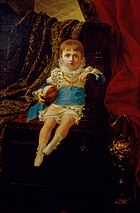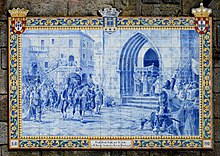John IV of Portugal
| John IV | |
|---|---|
Roman Catholicism | |
| Signature |  |
John IV (Portuguese: João,[2] pronounced [ʒuˈɐ̃w]; 18 March 1604 – 6 November 1656), nicknamed John the Restorer (Portuguese: João, o Restaurador), was the King of Portugal whose reign, lasting from 1640 until his death, began the Portuguese restoration of independence from Habsburg Spanish rule.[1] His accession established the House of Braganza on the Portuguese throne, and marked the end of the 60-year-old Iberian Union by which Portugal and Spain shared the same monarch.
Before becoming king, he was John II, the 8th
Early life

John IV was born at
Reign
Accession

When
This situation culminated in a revolution organized by the nobility and the
Within a matter of hours and with popular support, John, then the 8th
Restoration War
His accession led to a protracted war with neighbouring Spain, a conflict known as the Portuguese Restoration War, which ended with the recognition of Portuguese independence in a subsequent reign (1668).[8] Portugal signed lengthy alliances with France (1 June 1641) and Sweden (August 1641) but by necessity its only contributions in the Thirty Years' War were in the field against Spain and against Dutch encroachments on the Portuguese colonies.
The period from 1640 to 1668 was marked by periodic skirmishes between Portugal and Spain, as well as short episodes of more serious warfare, much of it occasioned by Spanish and Portuguese entanglements with non-Iberian powers. Spain was involved in the Thirty Years' War until 1648 and the Franco-Spanish War until 1659, while Portugal was involved in the Dutch–Portuguese War until 1663. In Spain, a Portuguese invasion force defeated the Spanish at Montijo, near Badajoz, in 1644.
Imperial Recovery
Abroad, the Dutch took Portuguese Malacca (January 1641), and the Imam of Oman captured Muscat (1650). Nevertheless, the Portuguese, despite having to divide their forces among Europe, Brazil, and Africa, managed to retake Luanda, in Portuguese Angola, from the Dutch in 1648 and, by 1654, had recovered northern Brazil, which effectively ceased to be a Dutch colony. This was countered by the loss of Portuguese Ceylon (present day Sri Lanka) to the Dutch, who took Colombo in 1656.
Death and legacy
King John IV died in 1656 and was succeeded by his son Afonso VI. His daughter, Catherine of Braganza, married King Charles II of England.[3] Bombay in India was given as dowry to the English.
John was a patron of music and the arts, and a considerably sophisticated writer on music; in addition to this, he was a composer. During his reign he collected one of the largest libraries in the world, but it was destroyed in the
In 1646, John IV proclaimed Mary, in her conception as the Immaculate Conception (the 'Immaculata'), the Patroness of Portugal by royal decree of the House of Braganza. The doctrine had appeared in the Middle Ages and had been fiercely debated in the 15th and 16th centuries, but a bull issued in 1616 by Pope Paul V finally "[forbade] anyone to teach or preach a contrary opinion."[11] Three years later, in 1649, the iconography of the Immaculata was established by Francisco Pacheco (1564–1654), a Spanish artistic advisor to the Inquisition, based on Revelation XII:1.[12]
Marriages and descendants
John married
| Name | Birth | Death | Notes |
|---|---|---|---|
| By Luisa de Guzmán (13 October 1613 – 27 February 1666; married on 12 January 1633) | |||
| Infante Teodósio | 8 February 1634 | 13 May 1653 | Prince of Brazil and 9th Duke of Braganza. Died young. |
| Ana de Bragança | 21 January 1635 | 21 January 1635 | |
| Infanta Joana (Joan) | 18 September 1635 | 17 November 1653 | |
| Infanta Catherine (Catarina) | 25 November 1638 | 31 December 1705 | Commonly known as Catherine of Braganza. Queen consort through marriage to Charles II of England. |
| Manuel de Bragança | 6 September 1640 | 6 September 1640 | |
| Infante Afonso | 21 August 1643 | 12 September 1683 | Prince of Brazil and 10th Duke of Braganza. Succeeded him as Afonso VI, King of Portugal .
|
| Infante Peter (Pedro) | 26 April 1648 | 9 December 1706 | Duke of Beja, Constable of the Kingdom, Lord of the King of Portugal .
|
| Illegitimate offspring | |||
| Maria de Bragança | 30 April 1644 | 7 February 1693 | Natural daughter. |
Ancestry
| Ancestors of John IV of Portugal | |||||||||||||||||||||||||||||||||||||||||||||||||
|---|---|---|---|---|---|---|---|---|---|---|---|---|---|---|---|---|---|---|---|---|---|---|---|---|---|---|---|---|---|---|---|---|---|---|---|---|---|---|---|---|---|---|---|---|---|---|---|---|---|
| |||||||||||||||||||||||||||||||||||||||||||||||||
References
- ^ ISBN 9789726160823.
- ^ Also rendered as Joam in Archaic Portuguese
- ^ a b Jayne, Kingsley Garland (1911). . In Chisholm, Hugh (ed.). Encyclopædia Britannica. Vol. 22 (11th ed.). Cambridge University Press. p. 148.
- ISBN 978-0-521-44796-6.
- ^ Dyer, Thomas Henry (1877). 1593–1721. p. 340.
- ^ Sousa 1741, Vol VII, p. 238.
- ISBN 978-1584774228.
- ^ One or more of the preceding sentences incorporates text from a publication now in the public domain: Chisholm, Hugh, ed. (1911). "John IV. of Portugal". Encyclopædia Britannica. Vol. 15 (11th ed.). Cambridge University Press. p. 444.
- ^ Grove Dictionary of Music: Doubtful: Crux fidelis, 4vv, D-Dlb; ed. G. Schmitt, Anthologie universelle de musique sacrée (Paris, 1869); ed. J. Santos, A polifonia clássica portuguesa (Lisbon, 1937)
- ^ Bartomomé Estebán Murillo and Nancy Coe Wixom, "The Immaculate Conception", The Bulletin of the Cleveland Museum of Art, Vol. 47, No. 7 (Sept, 1960), p. 163.
- ^ Anna Jameson, Legends of the Madonna, Boston & New York, 1895, p. 14.
- ^ Bourn, Thomas (1815). A Concise Gazetteer of the Most Remarkable Places in the World; with brief notices of the principal historical events ... connected with them, etc. p. 413.
- ^ ISBN 9780722224731. Retrieved 11 July 2018.
Bibliography
- Sousa, António Caetano de. História genealógica da Casa Real portuguesa (in Portuguese). Vol. VII. Lisbon: Silviana.[ISBN missing]
External links
- Free scores by John IV of Portugal in the Choral Public Domain Library (ChoralWiki)
- Crux fidelis Recording of John IV's best-known choral work



